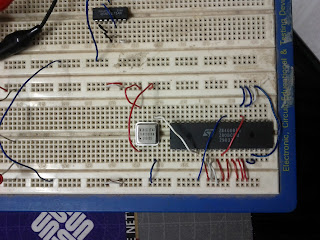Forward To The Past - 3
One tiny victory tonight:
If you tie all the data lines of a Z80 CPU low, then tie RST, BUSREQ, WAIT, INT and NMI high and apply a clock you get a rather large 16-bit counter. Using an oscilloscope or even a fast logic probe, you will see the address lines cycling through
Why? Well opcode 00 is NOP (No Operation), so the address counter just moves on to the next address. Other useful signs of life will be:
/MREQ and /RD will be low (we're reading memory) while /IOREQ and /WR will be high. HLT will also be high.
I would also recommend using a packaged crystal oscillator, as it's just one less thing to have to get working.
So for our first test, the wiring will be:
Pin Signal Tie-to
16 /INT +5
17 /NMI +5
24 /WAIT +5
25 /BUSREQ +5
26 /RST +5
7 D4 GND
8 D3 GND
9 D5 GND
10 D6 GND
12 D2 GND
13 D7 GND
14 D0 GND
15 D1 GND
11 VCC +5V
29 GND GND
Here's a schematic for this simple stage. Note that the schematic assumes a 14 pin oscillator, whereas the photo shows an 8-pin device. The layout of the device is the same however.




Comments
Post a Comment